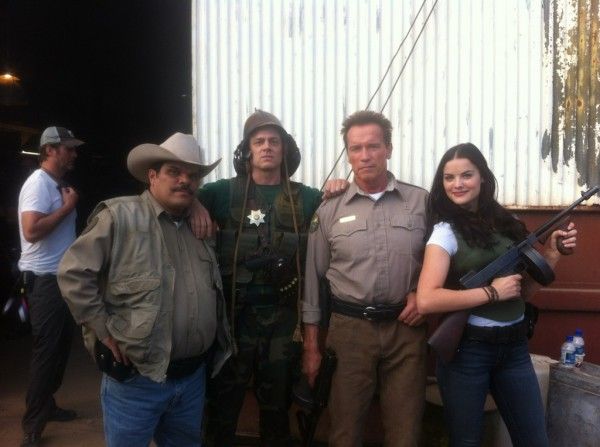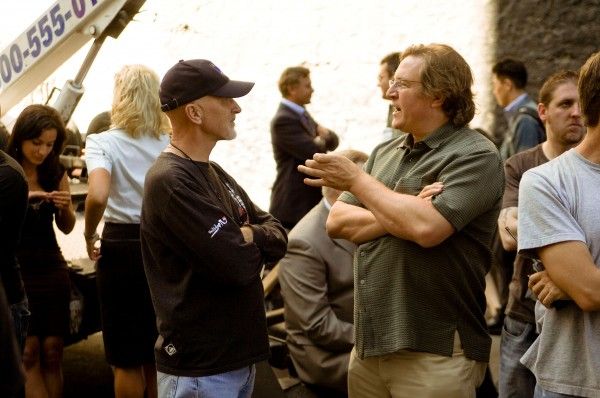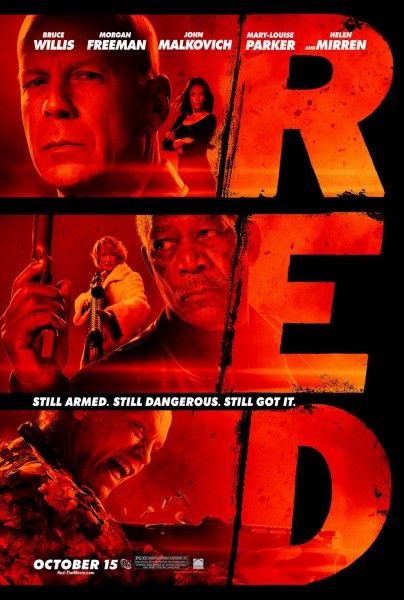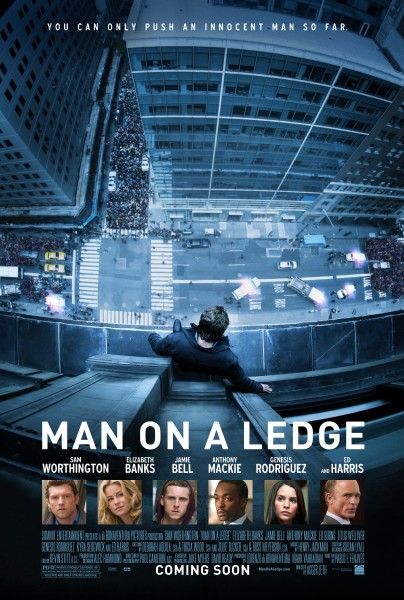Since his days as president of production at Warner Bros., producer Lorenzo di Bonaventura had wanted to turn the script for Man on a Ledge into a film. He felt there was an inherent drama to the idea and saw it as a movie where things keep turning on themselves. There was something gripping about the idea of a man on a ledge and whether he was going to jump or not. What attracted him to the script was the potential for impending catastrophe and the possibility for a strong interactivity between the guy on the ledge and the people down below on the ground.
We sat down with di Bonaventura at a roundtable interview recently to talk about how he came aboard to help produce this film. He told us about the similarities Man on a Ledge shares with Red, why it’s dangerous to make movies that have disparate tones, why he would not have made the project without Sam Worthington, and why he enjoys making both smaller, intimate films like this and huge, spectacular films like Transformers. He also confirmed there will be a Red 2 and a Transformers 4, discussed his Arnold Schwarzenegger project, Last Stand, which South Korean director Jee-woon Kim is currently filming, and revealed his plans to make a Western with Bruce Willis entitled Five Against the Bullet.
Is there any chance you’d stand out on a ledge?
LORENZO DI BONAVENTURA: (laughs) I stood out on the ledge. I wouldn’t ask my actors or anybody else to do that if I wasn’t willing to do it. That’s the truth. I think I was one of the first people out on the ledge.
So you did it literally and figuratively since you were out on a ledge taking on this project too?
DI BONAVENTURA: It was a crazy decision to make this movie. It’s interesting. I hadn’t really thought about it until today when people asked me questions. It has a lot in common with Red in that it has all these disparate tones, and it’s really dangerous to me to make movies with disparate tones because how do they all come together? At Warner Bros., in particular, I had a few movies that I will leave unnamed, but they didn’t coalesce together. It’s really dangerous when you do it.
Why is it so hard?
DI BONAVENTURA: I think there’s this internal mechanism for you as an audience member, for me as an audience member, where you go “Okay, I’m in this action movie. Wait! No, I’m not. I’m in ?? No, I’m not. Wait a second. What the hell are you guys doing?” There has to be something that bridges that tone. In Red, it was everybody played it utterly straight. That was the thing that allowed you to be incredibly violent and incredibly funny. In this (Man on a Ledge), everybody played it like life or death. I think that notion of standing on the ledge was something that really dominated everybody’s perspective on it, both metaphorically and realistically, because when you stand on a ledge, you really get a view. You get the attention really fast. Sam (Worthington) was brave as hell because he’s afraid of heights. You have an internal mechanism. We all have it. It’s called “fight or flight.” Your flight mechanism is surging adrenaline through your system when you’re standing up there all day long. He was beyond exhausted at the end of the day.
Would you have done the movie without Sam?
DI BONAVENTURA: I don’t think so. Also, it was sort of a narrow timeframe. No, my suspicion is we would not have made it. Sam had some great creative instincts that really helped the script coalesce together early in the development process. He brought a lot to the table. There were certain things that he felt really strongly about. For instance, the Ed Harris character, a lot of his physical proximity was not in the building in the way we made it happen in this. And so, in particular, what he helped us do was he wanted his participation in the movie to be really centric to the building. There’s an element in it where he’d gotten off the building. In the original script, I think there was probably a whole act, maybe 40 pages, where he’d gotten off and the plot was continuing on. And now, you get off and the movie ends. That’s his particular contribution which I think was really great and very helpful.
What is it that you look for that helps determine whether you want to come in and shepherd a project to fruition? Do you feel like you’re taking a big chance on your Arnold Schwarzenegger’s movie, Last Stand?
DI BONAVENTURA: That’s not mine. Lionsgate has to pay for it. I don’t have to pay for it. (laughs) I actually don’t think that’s that big of a risk. I think having been a studio executive for so long, you find what it is in each project that appeals to you and that’s the thing you focus on. You mentioned Arnold’s project, the thing that’s interesting to me is Kim Jee woon is one of the great directors of our time and how do you get a guy who doesn’t speak English to make an English-speaking movie. It wasn’t originally envisioned with Arnold. So that was the challenge. It’s been a fascinating experience because he still doesn’t speak English and yet he is able to direct the actors by emphasis and by physical motion. He can tell literally tone and not content. I find that really interesting. I’m learning something from that. I learned something about directing through that thing, where it isn’t about the words. It’s actually about your physical presence and your enunciation of the word, which you don’t really think about. I was watching it and the direction is so precise. I kept thinking how is this occurring? He has an interpreter, but the interpreter isn’t sitting there saying everything. Then, you realize, when you really think about it, that is what acting is really when you get down to it. That’s what I find. I usually find something in every project where it really gets [interesting]…you know…and creatively, hopefully, there’s something. With Man on a Ledge, I was always fascinated when Pablo (Fenjves) wrote the spec script and it was sold to MGM. I was at Warners and I tried to buy it and we lost it. I was always fascinated with this idea of will a man jump or won’t he jump. There’s something in that life and death and that sense of desperation that I find really compelling. And yet, how to make that entertaining was an incredible challenge.
Is the experience of producing a small, more intimate film like this really different from doing something huge and spectacular like Transformers?
DI BONAVENTURA: Both are incredibly complicated and sometimes the smallest movie… I worked on Devil Inside which came out this weekend. It was a $950,000 movie.
It’s doing really well.
DI BONAVENTURA: We’re doing great. It’s unbelievable actually. We’re kind of like “Oh wow!” Each movie has a different dynamic. The thing about the really big movies is, the closest analogy I can give you to what the experience of it is, is they’re like a steamroller, sort of like that guy in Tiananmen Square when he stepped in front of the tank and the tank stopped. If you try to stand in front of a steamroller, one of two things is going to happen. It’s either going to run you over or it’s going to veer off onto the sidewalk and kill a lot of people. So, once it gets in motion, there’s no way to stop a big movie, a Transformers, a G.I. Joe, those kind of movies. They’re just an impetus to them that is into and of itself. You never get a chance to go “Okay, we’ve got our arms around this now. Alright, we’re good. Let’s go.” Small movies are different in that you don’t have enough resources and that’s the steamroller – there’s not enough of a steamroller. There’s a little desperation to it, for sure. This one particularly was because this movie, I think at the end of the day, was something like $37 or $38 million bucks. This has scale. It has visual effects. It has real stars. How do you fit all that into that pot and actually come out with something that’s coherent? Actually, one of the most exciting things in making this movie was we had seven days where we closed Madison Avenue. We had to get everything in seven days. At some point, we were realizing we weren’t going to get it and we were adding camera crews as the hours were going by. I think by the end of that last day, we had five crews shooting or elements with five cameras going. So, it was really kind of pandemonium. I like the rush of that. It’s kind of a narcotic.
Which do you prefer? Big or small?
DI BONAVENTURA: I like them both. I think I would get bored of either if I didn’t switch them up. I think that’s probably the truth. You’re totally exhausted at the end of a film like Transformers because it’s like guerilla war at a long and sustained pace. It’s exhausting. That’s one of the great things about smaller movies is they end quickly. You’re like “Okay! Alright! Whew! I can breathe again.”
How you see the future of Hollywood in terms of what kinds of films are going to be made and in terms of the technology?
DI BONAVENTURA: I can tell you what I hope. I hope we get more provocative because I think the industry is just not willing to take enough risk, creatively and financially. Financially, that’s probably not true because these movies cost a fortune. But, I think there’s some apathy in the audience and I think they’re right to have a little apathy because we’re not either making a good enough movie or a provocatively fresh enough movie. My hope is we get back to making some of those movies.
In whose hands are those decisions to make more provocative movies?
DI BONAVENTURA: The guys with the money, at the end of the day. I mean, we can bring them forward as much as we want, but you’ve got to find somebody that will pay for it.
Where does The Devil Inside fit into that scenario?
DI BONAVENTURA: What’s great about that is it was made for $950,000 so there’s actually a gentleman by the name of Morris Paulson who’s the producer on it and he basically self-financed the movie. In that case, if you make a movie that small, it’s possible to self-finance it. The challenge there is how do you get anybody to pay attention to that small of a movie.
And the answer is, because you’ve done it?
DI BONAVENTURA: We did it. I don’t know if there was an answer exactly because I think it usually takes about a year after it to sort of evaluate exactly what the hell happened. I’ll say this as a lapsed Catholic, I think the notion of the Devil and Exorcism is a deep core reaction to that. I did a movie called Devil’s Advocate when I was at Warner Bros., and if you look at its international grosses, it was gigantic in Spain, gigantic in Italy, gigantic in Brazil. You go to the Catholic countries, they’re coming to see it. And, no matter how much the church tells them not to come to see it, they’re coming to see it because there’s something compelling about that notion of heaven and hell.
Guilt is a wonderful thing.
DI BONAVENTURA: Guilt is part of that train, yeah.
And it’s not restricted to Jews.
DI BONAVENTURA: There you go! That’s right. (laughs) Everybody relates to that in some way or another. I was actually interested in exploring it further after Devil’s Advocate because I just saw what it makes people ask themselves as an audience member. Yes, there’s scares and all that stuff, but I think really it’s fundamentally an uncomfortable experience to think about “Is this possible?”
One thing we’re seeing now in the film industry that is taking a lot of people by surprise is the success of The Expendables. The geriatric generation of action heroes is coming back and you’ve got Bruce Willis back in G.I. Joe 2. What do you attribute this to with the public embracing all of these aging action stars who still physically are pretty much at the top of their game?
DI BONAVENTURA: I’m not sure I can answer that exactly, although I pushed to make Red because I believed there was an audience that was going to embrace it. Everybody who grew up with those people was going to come see it. I thought at the time, and I guess it proved out right, that there’s a lot of people between 40 and 70 years old who want to see it and they have a lot of income. So I think that’s part of the reality of it. Also, we go in cycles. Action movies fell out of cycle for a period of time. They still are out of cycle by and large, I think. We’re more in an adventure PG13 safe cycle. So, I think you’re calling back sort of sense memory when you bring those guys back into it.
Will we see a Red 2?
DI BONAVENTURA: For sure.
What about a Transformers 4?
DI BONAVENTURA: Yeah, you’ll see that for sure, too. I think it’s inevitable.
How is Arnold doing?
DI BONAVENTURA: Arnold is doing great. He loves being back on the set. He’s really enjoying that and he is characteristically unafraid of what he’s trying to do. He’s really showing his age and showing in a very real way what it’s like to be 63 years old and trying to be in a situation like this – not in a comic way the way Red is. Kim Jee-woon is a real character-based director and so you’ll see him. Whether people like it or not I can’t answer that, but I think one of the surprises of the movie will be it’s not the way you’ve seen him before and yet there are echoes of what you want to see Arnold doing.
What do you think of the future of 3D movies?
DI BONAVENTURA: I think having done one of them now, I’m not the biggest expert, but I will say in looking at what occurred, Asia has so embraced 3D that it’s going to force Hollywood to embrace 3D in a way that they might not otherwise. It’s a lot more expensive to do it right than people think. And so, I think the thing that is holding back right now more 3D is it’s really expensive. The technology, however, is improving beyond rapidly. I think eventually it’s going to get at a cost place where it can be done for a lot of movies and not done in this sort of half-assed way that some of these movies have done.
Do you think the home entertainment market in 3D is going to get established as a result of more 3D films being made?
DI BONAVENTURA: I don’t know. I hope so. We need some help!
That’s obviously one of the incentives being built into the home entertainment market. You guys still want us to buy Blu-rays?
DI BONAVENTURA: Yes, we do. (laughs) Please! That damn Netflix! Not to make fun of it, but I actually think there is a crisis going on. The amount of piracy is extraordinary. People don’t realize how big it is. One of the things that’s driving films in a particular direction is that the after market value of them is dropping really fast and in many segments of it, not just DVDs. Pay television is dropping. There’s elements and so the result is, if you’re a businessman and you’re running a studio and you suddenly realize your risk is rising dramatically, you’re getting safer and safer.
UltraViolet has been so poorly marketed by your industry as an incentive for people to go back to buying more Blu-rays that people…
DI BONAVENTURA: I don’t think we’ve ever done a good job of leading the consumer.
What other projects do you have coming up?
DI BONAVENTURA: There’s one called Five Against the Bullet which is really great and I think I have a shot at making a movie that will pay homage to movies like The Wild Bunch or The Magnificent Seven. It’s a hard core shoot-em up with men of questionable morality coming up against maybe their humanity as a result of it. I’m really excited about that because those movies are really hard to make because they can veer into just an action picture or they can speak to you in a way that’s different where you can get underneath the character. I aspire more to The Wild Bunch and The Magnificent Seven and hopefully we can pull it off.
Any casting so far?
DI BONAVENTURA: Well, Bruce Willis is probably going to do it. But there are five really great characters, so that’s what’s really fun. There’s actually a sixth character that is sort of a cameo that’s really interesting too. I think we’re going to be able to put together a very eclectic international cast and Sony is going to do the picture.
Man on a Ledge opens in theaters on January 27th.




